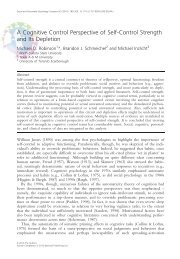Emotions and self-control 1 Incidental and Integral ... - Michael Inzlicht
Emotions and self-control 1 Incidental and Integral ... - Michael Inzlicht
Emotions and self-control 1 Incidental and Integral ... - Michael Inzlicht
You also want an ePaper? Increase the reach of your titles
YUMPU automatically turns print PDFs into web optimized ePapers that Google loves.
<strong>Emotions</strong> <strong>and</strong> <strong>self</strong>-<strong>control</strong> 28<br />
Errors are not neutral events; rather, errors are distressing because of the negative consequences<br />
typically associated with them. Hajcak <strong>and</strong> colleagues (2003), for example, found that errors<br />
prompt rapid changes in autonomic arousal, including increased skin conductance <strong>and</strong> greater<br />
heart rate deceleration. Errors prompt more than an orienting response, however; they are also<br />
aversive <strong>and</strong> anxiety-inducing, with larger startle reflexes—an index of defensiveness—after<br />
errors than after correct responses (Hajcak & Foti, 2008). The more aroused people become after<br />
they make errors, the fewer errors they tend to make overall (Hajcak et al., 2003). In short,<br />
noticing errors contributes to adaptive <strong>control</strong>, <strong>and</strong> the reason people notice errors to begin with<br />
is because errors are arousing <strong>and</strong> aversive. So, here is more evidence that negative affect, in this<br />
case affect associated with errors, signals the need for remediation <strong>and</strong> <strong>control</strong>.<br />
Somatic marker hypothesis. The final theory we discuss shares a number of features with<br />
our own affect alarm model of <strong>control</strong>. According to Damasio (1994), emotional processes guide<br />
<strong>and</strong> bias behavior, specifically decision-making behavior. This hypothesis emerged in response<br />
to a number of observations of neurological patients with focal lesions to “emotional” parts of<br />
the brain, namely ventral <strong>and</strong> medial prefrontal regions. These patients exhibited severe deficits<br />
in personal <strong>and</strong> social decision-making, but otherwise exhibited largely intact intellectual<br />
abilities (Damasio, 1996). Further, these patients had compromised abilities to express emotion<br />
<strong>and</strong> experience feelings in situations in which emotions would normally have been expected. In<br />
other words, along with normal intellect <strong>and</strong> abnormal decision making, there were abnormalities<br />
in emotion <strong>and</strong> feeling. Damasio (1994, 1996) predicted <strong>and</strong> later confirmed that the deficits in<br />
emotions <strong>and</strong> feelings directly contributed to these patients’ deficits in decision making.<br />
The somatic marker hypothesis states that when persons make decisions, they assess<br />
the reward value of the available options using both cognitive <strong>and</strong> emotional processes. When



